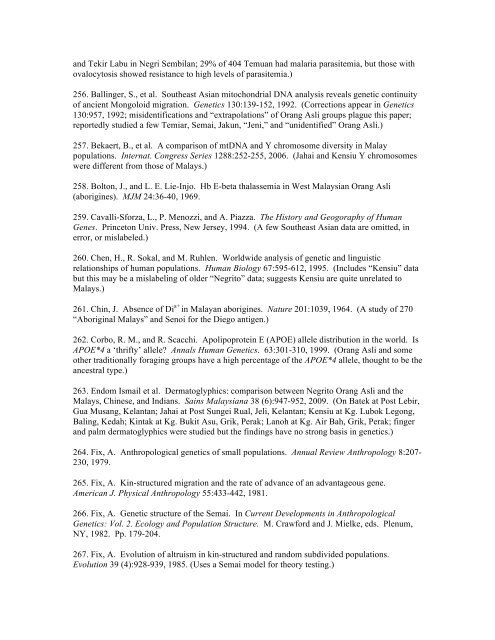Orang Asli (Indigenous Malaysian) Biomedical Bibliography AS Baer
Orang Asli (Indigenous Malaysian) Biomedical Bibliography AS Baer
Orang Asli (Indigenous Malaysian) Biomedical Bibliography AS Baer
Create successful ePaper yourself
Turn your PDF publications into a flip-book with our unique Google optimized e-Paper software.
and Tekir Labu in Negri Sembilan; 29% of 404 Temuan had malaria parasitemia, but those with<br />
ovalocytosis showed resistance to high levels of parasitemia.)<br />
256. Ballinger, S., et al. Southeast Asian mitochondrial DNA analysis reveals genetic continuity<br />
of ancient Mongoloid migration. Genetics 130:139-152, 1992. (Corrections appear in Genetics<br />
130:957, 1992; misidentifications and “extrapolations” of <strong>Orang</strong> <strong>Asli</strong> groups plague this paper;<br />
reportedly studied a few Temiar, Semai, Jakun, “Jeni,” and “unidentified” <strong>Orang</strong> <strong>Asli</strong>.)<br />
257. Bekaert, B., et al. A comparison of mtDNA and Y chromosome diversity in Malay<br />
populations. Internat. Congress Series 1288:252-255, 2006. (Jahai and Kensiu Y chromosomes<br />
were different from those of Malays.)<br />
258. Bolton, J., and L. E. Lie-Injo. Hb E-beta thalassemia in West <strong>Malaysian</strong> <strong>Orang</strong> <strong>Asli</strong><br />
(aborigines). MJM 24:36-40, 1969.<br />
259. Cavalli-Sforza, L., P. Menozzi, and A. Piazza. The History and Geogoraphy of Human<br />
Genes. Princeton Univ. Press, New Jersey, 1994. (A few Southeast Asian data are omitted, in<br />
error, or mislabeled.)<br />
260. Chen, H., R. Sokal, and M. Ruhlen. Worldwide analysis of genetic and linguistic<br />
relationships of human populations. Human Biology 67:595-612, 1995. (Includes “Kensiu” data<br />
but this may be a mislabeling of older “Negrito” data; suggests Kensiu are quite unrelated to<br />
Malays.)<br />
261. Chin, J. Absence of Di a+ in Malayan aborigines. Nature 201:1039, 1964. (A study of 270<br />
“Aboriginal Malays” and Senoi for the Diego antigen.)<br />
262. Corbo, R. M., and R. Scacchi. Apolipoprotein E (APOE) allele distribution in the world. Is<br />
APOE*4 a ‘thrifty’ allele? Annals Human Genetics. 63:301-310, 1999. (<strong>Orang</strong> <strong>Asli</strong> and some<br />
other traditionally foraging groups have a high percentage of the APOE*4 allele, thought to be the<br />
ancestral type.)<br />
263. Endom Ismail et al. Dermatoglyphics: comparison between Negrito <strong>Orang</strong> <strong>Asli</strong> and the<br />
Malays, Chinese, and Indians. Sains <strong>Malaysian</strong>a 38 (6):947-952, 2009. (On Batek at Post Lebir,<br />
Gua Musang, Kelantan; Jahai at Post Sungei Rual, Jeli, Kelantan; Kensiu at Kg. Lubok Legong,<br />
Baling, Kedah; Kintak at Kg. Bukit Asu, Grik, Perak; Lanoh at Kg. Air Bah, Grik, Perak; finger<br />
and palm dermatoglyphics were studied but the findings have no strong basis in genetics.)<br />
264. Fix, A. Anthropological genetics of small populations. Annual Review Anthropology 8:207-<br />
230, 1979.<br />
265. Fix, A. Kin-structured migration and the rate of advance of an advantageous gene.<br />
American J. Physical Anthropology 55:433-442, 1981.<br />
266. Fix, A. Genetic structure of the Semai. In Current Developments in Anthropological<br />
Genetics: Vol. 2. Ecology and Population Structure. M. Crawford and J. Mielke, eds. Plenum,<br />
NY, 1982. Pp. 179-204.<br />
267. Fix, A. Evolution of altruism in kin-structured and random subdivided populations.<br />
Evolution 39 (4):928-939, 1985. (Uses a Semai model for theory testing.)















